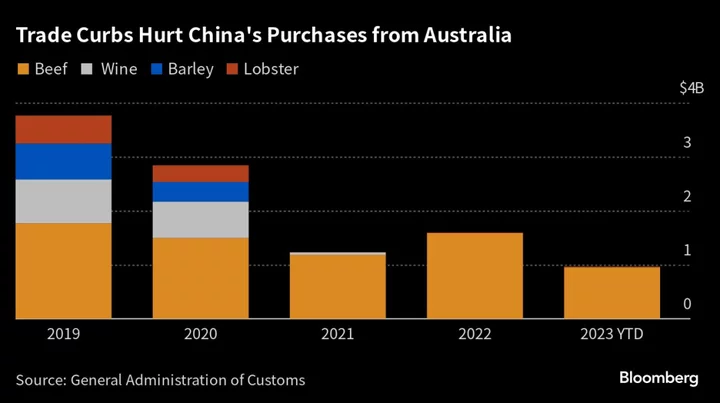Three years of trade curbs have gutted Australia’s exports to China across a bunch of commodities, from luxury items like lobster to vital fuels like coal.
Beijing imposed a variety of restrictions in 2020, from tariffs to unofficial bans, after Australia called for an international investigation into the origins of Covid-19. It capped a souring of relations that began in 2018, when Canberra barred Huawei Technologies Co. from participating in its 5G network.
Losing their biggest market has been hard to bear for many exporters, but prospects have improved immensely this year as some of the restrictions have been rolled back. Barley sales are the latest to benefit from a thaw in political tensions after Beijing scrapped its duties on the Australian grain earlier this month.
It follows probably the biggest breakthrough that came at the start of the year, when China rescinded its ban on Australian coal. Controls on cotton and timber have also eased in recent months, while restrictions remain in place on wine, lobster and beef. Exports of copper ore have collapsed to negligible amounts since Chinese traders were ordered to halt purchases at the end of 2020.
Taking 2019 as a baseline, over the three years from 2020 to 2022, export revenue affected across those eight commodities totaled about $31 billion, according to a calculation based on Chinese customs data. That’s not an enormous amount of money as a proportion of Australia’s overall exports of goods, which topped $400 billion last year. And it counts for even less in China’s vastly bigger economy. But some individual industries have found it challenging to cope with the collapse in demand and find new markets.
Hopes are running high that wine might be the next export to see duties lifted. “There is no market or collection of markets that can replace the China market,” said Lee McClean, chief executive officer of industry body Australian Grape and Wine.
That said, the relationship between the trade partners is unlikely to return to how it was, McClean said. “Some Australian businesses will be somewhat cautious in their return to the market following the impacts the import duties had on many businesses,” he said.
Before the tariffs, China accounted for 18% of Australia’s wine export volume, but 40% of its value, according to Rabobank analyst Pia Piggot. “China was a high-value market for Australian commercial wine and tariffs have caused a loss of premium,” she said. “The premium loss has had a large impact on the industry.”
Australia’s Prime Minister Anthony Albanese said earlier this month he plans to bring up the trade impediments that remain on wine, lobster and some beef exporters when he next meets with his Chinese counterpart Xi Jinping. The Australian leader is weighing a trip to Beijing to hold talks before the end of the year.
China is the biggest buyer of Australian commodities, which has allowed Beijing to use trade as a tool to amplify its diplomatic efforts, or as a cudgel to score political points, depending on your viewpoint. At the same time, the government has avoided targeting Australia’s top export earners, like iron ore and natural gas, in all likelihood because those are commodities on which its economy relies.
Arguably, China only began letting in Australian coal because it was fearful of gaps in supply emerging that could hurt power generation and steel production as its economy reopened after the pandemic. In any case, Australia’s coal industry probably better weathered the ban better than other sectors.
The first six months were difficult, not least for Chinese steelmakers who had to find new supply at higher prices or lower quality, said Gerhard Ziems, chief financial officer at metallurgical coal producer Coronado Global Resources Inc.
China ended up buying more from the US and Russia, while European buyers shifted to Australia. “It took about six months, and then prices climbed up,” he said, leaving Coronado in a “much stronger” position than before the embargo.
Coronado is no longer selling any Australian cargoes to China, despite the lifting of the ban, as markets like India are now more lucrative. BHP Group Ltd., a long-time major supplier of metallurgical coal to China, has also said Indian steelmakers have picked up much of the slack.
The Week’s Diary
(All times Beijing unless noted.)
Monday, Aug. 21
- China sets monthly loan prime rates, 09:15
- EARNINGS: Tongwei, Goldwind, Anhui Conch
Tuesday, Aug. 22
- EARNINGS: Chalco, China Resources Power
Wednesday, Aug. 23:
- CCTD’s weekly online briefing on Chinese coal, 15:00
- EARNINGS: China Oilfield, Yunnan Energy
Thursday, Aug. 24:
- Power System and Green Energy Conference in Shanghai, day 1
- EARNINGS: China Coal, ENN Energy, Eve Energy, Sungrow
Friday, Aug. 25:
- China weekly iron ore port stockpiles
- Shanghai exchange weekly commodities inventory, ~15:30
- Power System and Green Energy Conference in Shanghai, day 2
- EARNINGS: Shenhua, CMOC, Jiangxi Copper, Tongling Metals, Zijin Mining, Huayou Cobalt
Saturday, Aug. 26
- Power System and Green Energy Conference in Shanghai, day 3
Sunday, Aug. 27
- China’s industrial profits for July, 09:30
- EARNINGS: Sinopec
On the Wire
Chinese banks made a smaller-than-expected cut to their benchmark lending rate and avoided trimming the reference rate for mortgages, despite the central bank putting pressure on lenders to boost loans.
Xi Jinping’s quest to rewrite the playbook that drove China’s economic miracle for a generation is facing its sternest test yet.
--With assistance from Dennis Ting, James Fernyhough and Keira Wright.

